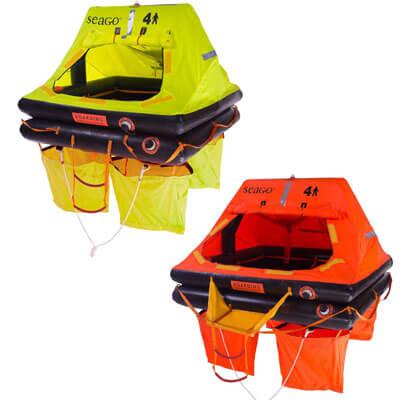Liferaft Selection Guide
Liferafts are essential safety equipment for yachts making a coastal, offshore, or ocean passage.
The range of liferafts available on the market can make it challenging to choose the right one.
Regulations can help guide the way, but there may be better options than the statutory minimum.
Liferaft History
History gives us a helpful insight into the development of the modern liferaft range.
The ill-fated maiden voyage of the Titanic in 1912 highlighted the need to provide adequate lifeboats on board.
By 1914, the Safety Of Life At Sea (SOLAS) treaty had been created, but successive world wars slowed the development of the treaty.
In 1960 the International Maritime Organisation (IMO) developed the first international SOLAS convention, which came into force in 1965.
The notable 1974 version improved the IMO’s ability to update the treaty and move swiftly to make improvements.
The 1979 Fastnet Race tragedy highlighted the need to develop the leisure industry regulations further.
As a result, liferafts became mandatory for all offshore racing yachts regardless of length.
The final tragedy to shape the development of the modern Liferaft occurred in 1998 with the Sydney to Hobart race.
Many liferafts deployed during the infamous storm could not withstand the conditions and failed.

ISO standard
ISO is an acronym for the International Organisation for Standardisation
The ISO standard is a strict set of guidelines designed to ensure they attain a minimum level of performance.
With the ISO standard established, current regulations dictate that:
- All vessels over 45 feet in length must carry an ISO 9650 standard liferaft (excluding inland waterways)
- All vessels for commercial charter must carry an ISO 9650 standard liferaft.
In addition to the statutory requirements of leisure vessels listed above, yachts of all lengths taking part in offshore racing are also subject to further race regulations.
Yachts that wish to participate in Offshore Racing or Organised Rallies will almost certainly need to comply with the WORLD SAILING OFFSHORE SPECIAL REGULATIONS.
The World Cruising Club is well known for organising a series of Offshore and Ocean Rallies, most prominently the ARC (Atlantic Cruising Rally) and if you are participating you will need to comply with their rules: WORLD CRUISING CLUB SAFETY EQUIPMENT REGULATIONS
These regulations usually stipulate additional minimal contents to be packed within the raft.
This has led to ISO liferafts being listed as appropriate for rescue after or within 24 hours.
Liferafts packed for rescue after 24 hours have more food and water rations, pyrotechnics, medical supplies, informational cards, and a general kit.
Models packed with contents for rescue within 24 hours can often be supplemented with SOLAS B or A packs to allow them to conform.
SOLAS A packs have a slightly more comprehensive kit list but are usually only required for commercial yachting.
Refer to the rules issued by your race organisers to determine the required specifications for your race.
However, the minimum specification required by race regulations or statutory law should not deter you from seeking a higher-specified product.
Current regulations do not require leisure yachts under 45 feet to carry a liferaft.
However, carrying a standard offshore liferaft from a recognised manufacturer means you will exceed the requirements required by the MCA code of practice.
Offshore liferafts do not have to meet a specific standard, so please be sure to take advice and compare the rafts before making your choice.
Under 45 feet:
- Coastal cruising – Offshore liferaft, consider ISO liferaft under 24 hours for longer passages
- Cross Channel Cruising – ISO liferaft under 24 hours
- Offshore Cruising – ISO Liferaft, consider over 24-hour packs
- Transocean – ISO Liferaft with an over 24-hour pack
Over 45 feet:
- ISO Liferaft minimum requirement; contact MCA for further guidelines
Charter Vessel, any length:
- ISO Liferaft minimum requirement; contact MCA for further guidelines
Offshore Racing:
- ISO Liferaft minimum requirement; contact the racing authority for exact requirements
If you are unsure which liferaft is most suitable, we can help you choose.
Jimmy Green Marine can supply any liferaft from the Seago range.
Export to marinas all over the world is available to service your needs













